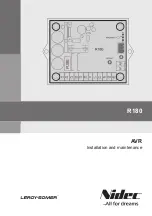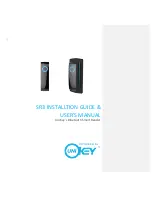
54
FORM 160.54-M1
ISSUE DATE: 10/25/2019
SECTION 4 - MICROBOARD 031-02430-000 AND 031-02430-001
JCI COMPANY CONFIDENTIAL
JOHNSON CONTROLS
Style B Solid State Starter Interface
Prior to June 2006, new production starters commu-
nicate with Microboard 031-02430-000 via the Opto-
coupled COM5 serial data port (J15) using YORK pro-
prietary protocol. The serial data is represented by +5
VDC and 0 VDC logic levels. TX data to the starter is
at J15-1. RX data from the starter is at J15-2. Between
June 2006 and mid 2008, new production chillers com-
municate with Microboard 031-02430-001 using the
same protocol.
After mid 2008, new production Starters communicate
with Microboard 031-02430-001 via COM 2 serial
port (J13) using RS-485 Modbus protocol (requires
software version C.OPT.01.18.307 or later). COM 2
serial port is selectable between RS-232 and RS-485
with Program Jumper JP17. It must be positioned on
pins 1 and 2 to select RS-485 serial port operation. To
allow Microboard 031-02430-001 to be used as service
replacement for 031-01730-000 or 031-02430-000
boards non-modbus applications in the field, the COM
5 serial port is retained on the 031-02430-001 board.
With Microboard 031-02430-001 and software version
C.OPT.01.18.307 (or later), when SSS-Mod B is se-
lected as the motor drive type on the SETUP Screen,
additional setpoints must be entered on this screen.
The appropriate serial port (COM 2-Modbus or COM
5 YORK) must be enabled using the Motor Communi-
cations Protocol setpoint. The selections are Modbus or
“YORK”. When Modbus is selected, the Motor Node
ID setpoint must be set to match the setting of the Start-
er Logic/Trigger Board Modbus Address Switch SW1.
They must be both be set to “1”.
See
and
for details of the solid state starter
interface.
Variable Speed Drive Interface
Prior to June 2006, new production Variable Speed
Drives communicate with Microboard 031-02430-000
via the Opto-coupled COM5 serial data port (J15) us-
ing a YORK proprietary protocol. The serial data is
represented by +5 VDC and 0 VDC logic levels. TX
data to the starter is at J15-1. RX data from the starter
is at J15-2. Between June 2006 and March 2007, new
production VSD communicate with Microboard 031-
02430-001 using the same interface/protocol.
After March 2007, new production Variable Speed
Drives communicate with Microboard 031-02430-001
via COM2 serial data port (J13) using RS-485 Modbus
protocol. Software version C.OPT.01.16.xxx (or later)
is required for COM2 Modbus operation. COM2 se-
rial port is selectable between RS-232 and RS-485 with
Program Jumper JP17. It must be positioned on pins
1 and 2 to select RS-485 serial port operation. With
the VSD Modbus applications, the Adaptive Capacity
Control (ACC) functionality is contained in the mi-
croboard and the ACC Board is not used.
To allow Microboard 031-02430-001 to be used as ser-
vice replacement for 031-01730-000 or 031-02430-000
boards non-Modbus applications already in the field,
the COM5 serial port is retained on the 031-02430-001
board.
With Microboard 031-02430-001 and software version
C.OPT.01.16.xxx (or later), when “VSD-60Hz” or
“VSD-50Hz” is selected on the SETUP Screen as the
Motor Drive Type, additional setpoints must be entered
on this Screen. The appropriate serial port (COM2-
Modbus or COM5-YORK) must be enabled using the
Motor Communications Protocol setpoint. The selec-
tions are Modbus or “York”. When Modbus is select-
ed, the Motor Node ID setpoint must be set to match
the setting of the VSD Logic Board Modbus Address
Switch SW3. They must be both set to “1”.
There are two different types of Modbus protocol used,
ASCII Mod D/Vyper and RTU Raptyr. With software
version C.OPT.01.23.307 (and later), when VSD –
60Hz or 50Hz is selected for the Motor Drive Type
setpoint on the SETPOINTS Screen, the microboard
will poll on COM 2 alternating between the two proto-
cols until one of them responds or until an initialization
fault occurs. Once a valid response is received from
either VSD type, the microboard will “remember”
this, even after a power failure. This allows the correct
screens to be displayed after a power failure, without
repeating the poll interrogation. As long as the Motor
Drive Type is not changed, once the microboard deter-
mines which VSD type is connected, it will not poll for
the other. Only after a change of the Motor Drive Type
setpoint, will the alternating between the two types be
done again to determine the connected type.
See
and
for details of the
variable speed drive interface.
















































